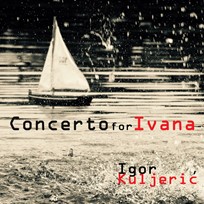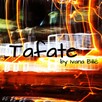
Concerto for Ivana (chamber version)
Composer: Igor Kuljerić
Instrument: Marimba, Percussion and Piano
Level: Advanced
Published: 2016
Price: €70.00
Item details
-
Description +
-
Duration: 30 min.
YouTube Performance:
Gregor Hrovat, Marimba
Renato Palatinuš, Percussion
Francesco Mazzoleni, Percussion
Krešimir Starčević, Piano at IPEW festival
The inspiration for the Concerto can be found in the African music and its rhythms and colors, the Gamelan tradition of rhythmical polyphony, with sounds and colors of wood, copper, glass, water… I wanted to merge the historic form of the concerto with the non European traditions that live in the roots of the instrument and experience the marimba as a particular kind of piano with equally distinctive percussive and singing qualities. The orchestration was extremely important and I have used it to emphasize marimba`s wonderfully characteristic colors. I gave a stronger percussive character to the strings for ex. The concerto is in three movements (following the traditional scheme fast-slow-faster) which are connected, the structure is complex and the transitions between musical situations are fast and driven by musical associations. The basic elements consist of small melodic and harmonic cells.
I used different compositional techniques and looked for inspiration in various musical styles. I have always tried to contradict the musicologists` assertions that the traditional musical vocabulary has been fully exploited. I believe that if we put in different relations the so-called „impressionists“ chord, polyrhythm’s or rhythmical repetitiveness (that are usually connected with specific composers) they will become a new and fresh material ready for new musical ideas and developments. Since my daughter is a marimbist, writing this concerto was in a way a family debt and I was very enthusiastic about it.“
-
-
Instrumentation +
-
Chamber Version (4 players)
Required Instruments:
1 Marimba (5 octave)
1 Piano
1 Guiro (for the pianist)
Percussionists:
4 Timpani
2 Shakers
1 Slapstick
1 Vibraphone + bow
6 Cymbals (2 sizzles, 2 crash, 2 high, medium, low)
3 pairs of Bongos
1 Bamboo Chimes
1 Wind/Glass Chimes
5 Temple Blocks
2 Glockenspiels
1 Maracas
1 Tam Tam (shared between the two percussionists)
1 Opera Gong
1 Tubular Bells
1 Bass Drum (+ switch)
1 Castagnettes
3 Tom-Toms
1 Darabuka
1 Triangle
-
-
Watch+
-
About the composer +
-
IGOR KULJERIĆ (Šibenik, 1938.-Zagreb, 2006.) is one of the most important Croatian composers. He graduated in composition from the Zagreb Academy of Music. After receiving a grant from the Italian government he studied opera repertoire at La Scala in Milan. He also took part in the experimental musical activities of the Studio di fonologia musicale at RAI along with Luigi Nono and other important figures of music avantgarde.
Kuljerić studied conducting with Igor Markevitch in Monte Carlo and debuted during the Northamerican tour of the Zagreb soloists. As conductor, he was appointed in the Opera of the Croatian National Theater and has regularly appeared with the Symphony orchestra and Choir of the Croatian radiotelevision. His guest appearences include international festivals and tours in the US, Russia, Israel, Germany, Spain, Italy, France and Austria. Kuljerić premiered many works by other composers and regularly recorded for radio, television and movies.
His most important student works are SYMPHONIC VARIATIONS, CONCERT OVERTURE, CONCERTO FOR FRENCH HORN AND ORCHESTRA, and I and II BALLET SUITES.
After graduation Kuljerić joined the avant-garde movement, his music sometimes reaching the limits of experiment. The works from that period include FIGURAZIONI CON TROMBA, SOLO-TUTTI, BALLADS OF PETRICA KEREMPUH, FOLK ART tape music, LES ECHOS I and II.
In the beginning of the '80s, he started to search for a more personal musical language, incorporating the tradition and the positive experiences of musical avant-garde. These features are present in his symphonic works RISUONO DI GAVOTTA and CHORAL OVERTURE, the collection ALLELUIA, PATER NOSTER and DIES IRAE for piano trio, CHOPIN OP.17 NO 4 for flute and vibes, WALTZ G9-D9 for chamber ensemble, solo concerti CONCERTPIECE, CONCERTO FOR IVANA, POP CONCERTO and BAROCCHIANA, ballet RIKY LEVI, with a later orchestra suite version, FIVE MOVEMENTS FROM THE BALLET RIKY LEVI and his last work BEL KAMEN KAMPANELA.
A special part of Kuljerić's opus refers to his Croatian roots with influences from the glagolitic religious practice and historical artistic practice (Renaissance poetry and Baroque music) and can be found in the choral works QUAM PULCHRA ES (OMMAGGIO A LUKAČIĆ), SEA, CROSS GIVE US MERCY, KANCONIJER, also in the string quartet SONG, just to be powerfully sublimed in his monolithic key works CROATIAN GLAGOLITIC REQUIEM and CROATIAN MASS.
He is the author of three operas: THE POWER OF VIRTUE, RICHARD III, ANIMAL FARM, CATHERINE OF ZRIN, his last opera, remained unfinished.
Kuljeric composed music for theater productions, movie soundtracks, crossover projects and was a particularly prolific arranger. He is the recipient of all the major Croatian awards and the UNESCO Award.
He was the artistic director of the MBZ, Concert Hall V. Lisinski, Dubrovnik Summer Festival (music program), Lovro Matačić Competition for Young Conductors and many more. He was the member of the Croatian Academy of Arts and Sciences.
-
-
Reviews +
-
Review (Percussive Notes, July 2016)
This is a chamber reduction of the original piece written for soloist Ivana Bilić and full orchestra. In this chamber version, the piano covers the wind, string, and even occasionally a guiro part, while due to the importance of the original percussion parts to the orchestral version, two percussionists are needed for this chamber setting utilizing quite a large amount of equipment. The composer states that his inspirations for the piece came from the African roots of the marimba as well as the rhythmically polyphonic traditions of Gamelan music.
Separated into three movements, the second and third contain cadenzas for the soloist. The first movement revolves around an agitated sixteenth-note line that takes on various forms throughout the movement. The second takes us on a journey through a number of musical areas, from an opening marimba chorale to more musically free interludes and a groovy moderato before the first cadenza. Both cadenzas are written out, and it should be noted that the marimba part was edited by Ivana Bilić, so stickings are written when necessary. The final movement begins with an aggressive Allegro before a Moderato that leads into the second cadenza. The composer then leads us through a number of other areas before finally ending the work with the soloist taking charge of the ensemble.
Technically, the piece would be very challenging for any soloist just in terms of the amount of notes that have to be played and the length of the work. Some of the sections are relentless with the density of notes, so anyone looking to approach this will need a good amount of chops. Likewise, given the amount of interaction at times as well as areas where things are in time but more polyrhythmic between soloist and ensemble, the ensemble players will also need to be quite solid performers.
“Concerto for Ivana” is an exciting and challenging project. At just under 30 minutes in length, this work would be a major undertaking for anyone. Students could feasibly program this as an entire half of a recital, while professionals will find a stimulating work that will be sure to showcase their talents.
—Brian Nozny
-
-
Credits +
-
Front Cover artist: Nikola Krbanjević
Photo: Claudia Hansen
Engraving: Vanja Kuljerić
Printed in Copenhagen, Denmark
Copyright © Edition SVITZER
www.editionsvitzer.com
-






